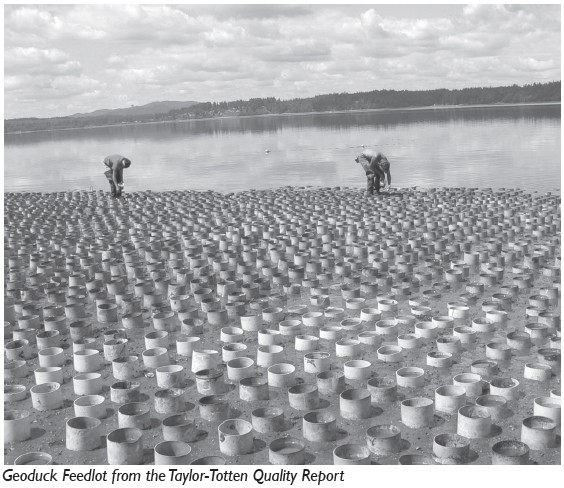Industrial Aquaculture: It's Not Your Grandfather's Oyster Farm AnymoreBy Laura Hendricks
The most aggressive expansion is in the commercial culture of geoducks, large burrowing clams. Geoduck aquaculture is expanding in our most pristine sandy/gravel beaches where the beaches are prepared like a pasture and native species purged and replaced with a monoculture of planted bivalves. One acre of tidelands typically contains more than forty thousand pipes, or about seventy five tons of PVC plastics stretched out along the shoreline. These pipes are then covered with large canopy nets. Two years later, the nets and pipes are removed, and the geoducks are left to grow for another three years. They are then harvested using pressurized high volume water guns to liquefy the tidal substrate, drilling three feet into the tidelands to extract the geoduck. Then the process of embedding plastic pipes begins again. Commercial aquaculture of non-native manila clams is also being conducted on beaches similarly on a permanent rotational basis. Clams are planted directly into the beach and then the entire area is covered with large polypropylene netting held down by steel rebar restricting native species from their feeding grounds. Plastic tubes, netting, rebar, and broken pieces of these components have been dislodged by wind and waves, and migrate to beaches and out into deeper waters where they could be ingested by marine species and seabirds. Eagles have been documented becoming entangled in shellfish aquaculture netting. Herring are also documented becoming entangled and perishing in aquaculture netting. Preliminary evidence suggests that geoduck harvest techniques suppress important prey species for salmon. PVC is also known to release dioxins. Walking on these once pristine beaches in no longer a pleasure and represents a hazard. Laura Hendricks is Chair of the Cascade Chapter of the Sierra Club. Laura. L.Hendricks@gmail.com or 253-509-4987.
Back to Home page. |

 In the tidelands and shorelines of Puget Sound, industrial aquaculture has been expanding at an alarming rate. These industrial ventures are taking place in the areas that support abundant wildlife and aquatic life, along rural residential shorelines, and along stretches of beach that have been enjoyed for beach combing, recreation, swimming, kayaking; and for the beauty and health that nature provides. In many cases, the Shoreline Management Act and the Public Trust Doctrine are violated by these activities.
In the tidelands and shorelines of Puget Sound, industrial aquaculture has been expanding at an alarming rate. These industrial ventures are taking place in the areas that support abundant wildlife and aquatic life, along rural residential shorelines, and along stretches of beach that have been enjoyed for beach combing, recreation, swimming, kayaking; and for the beauty and health that nature provides. In many cases, the Shoreline Management Act and the Public Trust Doctrine are violated by these activities.